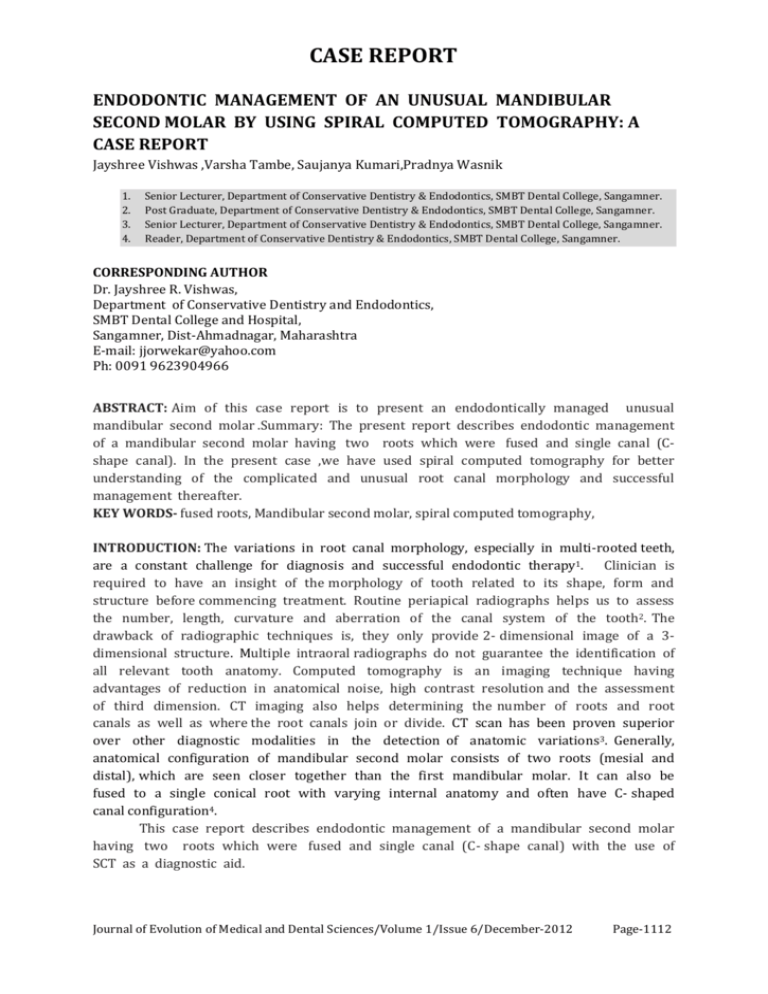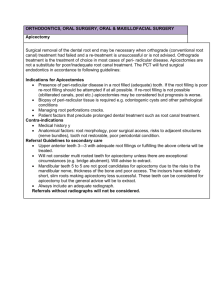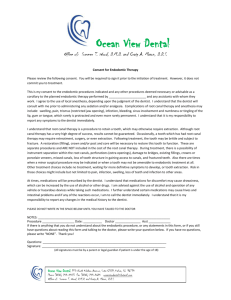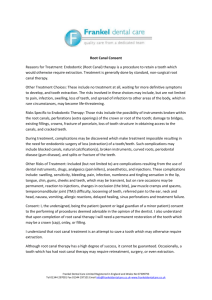This case report describes endodontic management of a
advertisement

CASE REPORT ENDODONTIC MANAGEMENT OF AN UNUSUAL MANDIBULAR SECOND MOLAR BY USING SPIRAL COMPUTED TOMOGRAPHY: A CASE REPORT Jayshree Vishwas ,Varsha Tambe, Saujanya Kumari,Pradnya Wasnik 1. 2. 3. 4. Senior Lecturer, Department of Conservative Dentistry & Endodontics, SMBT Dental College, Sangamner. Post Graduate, Department of Conservative Dentistry & Endodontics, SMBT Dental College, Sangamner. Senior Lecturer, Department of Conservative Dentistry & Endodontics, SMBT Dental College, Sangamner. Reader, Department of Conservative Dentistry & Endodontics, SMBT Dental College, Sangamner. CORRESPONDING AUTHOR Dr. Jayshree R. Vishwas, Department of Conservative Dentistry and Endodontics, SMBT Dental College and Hospital, Sangamner, Dist-Ahmadnagar, Maharashtra E-mail: jjorwekar@yahoo.com Ph: 0091 9623904966 ABSTRACT: Aim of this case report is to present an endodontically managed unusual mandibular second molar .Summary: The present report describes endodontic management of a mandibular second molar having two roots which were fused and single canal (Cshape canal). In the present case ,we have used spiral computed tomography for better understanding of the complicated and unusual root canal morphology and successful management thereafter. KEY WORDS- fused roots, Mandibular second molar, spiral computed tomography, INTRODUCTION: The variations in root canal morphology, especially in multi-rooted teeth, are a constant challenge for diagnosis and successful endodontic therapy1. Clinician is required to have an insight of the morphology of tooth related to its shape, form and structure before commencing treatment. Routine periapical radiographs helps us to assess the number, length, curvature and aberration of the canal system of the tooth2. The drawback of radiographic techniques is, they only provide 2- dimensional image of a 3dimensional structure. Multiple intraoral radiographs do not guarantee the identification of all relevant tooth anatomy. Computed tomography is an imaging technique having advantages of reduction in anatomical noise, high contrast resolution and the assessment of third dimension. CT imaging also helps determining the number of roots and root canals as well as where the root canals join or divide. CT scan has been proven superior over other diagnostic modalities in the detection of anatomic variations 3. Generally, anatomical configuration of mandibular second molar consists of two roots (mesial and distal), which are seen closer together than the first mandibular molar. It can also be fused to a single conical root with varying internal anatomy and often have C- shaped canal configuration4. This case report describes endodontic management of a mandibular second molar having two roots which were fused and single canal (C- shape canal) with the use of SCT as a diagnostic aid. Journal of Evolution of Medical and Dental Sciences/Volume 1/Issue 6/December-2012 Page-1112 CASE REPORT A CASE REPORT: A 40 year male patient referred from general dentist for the treatment of mandibular left second molar with Past history of endodontic treatment of the mandibular left first molar. Patient’s complaint was pain in the mandibular left region, continuous since last week. There was no evidence of swelling or sinus tract. Clinical examination revealed a large mesiobuccal cusp and small distobuccal cusp with deep occlusal caries in relation to mandibular second molar(Fig. 1A). Intraoral periapical radiograph of tooth revealed deep caries approximating the pulp without any associated periapical changes. Vitality test for heat and cold were positive. Based on clinical and radiographic findings, a diagnosis of chronic irreversible pulpitis of the left mandibular second molar was made. Endodontic treatment was planned for the tooth. A detailed examination of the radiograph revealed the presence of a single root with three canals meeting at apical third(fig. 1B) but , the exact anatomy of the tooth could not be clearly identified. To ascertain this complex, root canal anatomy of the tooth in a three dimensional manner, dental imaging with the help of spiral CT was planned. Informed consent was obtained from the patient and SCT imaging of the mandible was performed by using the dental software Dentascan (GE Healthcare, Milwaukee, WI). The involved tooth was focused, and the morphology was obtained in transverse, axial and sagittal sections of 0.5mm thickness, along with 3-dimensional reconstructed images.The SCT images revealed that the mandibular second molar had two roots fused and single canal. After confirmation of the diagnosis, instrumentation of the involved tooth was planned. Local anesthesia was administered and a rubber dam was applied. Endodontic access cavity was done by using a no. 2 round bur and EX 24 bur(non end cutting tapered fissure; Mani, Tochigi, Japan). Pulp extirpation was performed by using a barbed broach (Dentsply Maillefer, Ballaigues, Switerzland) and K-files (Mani Inc, Togichi, Japan). The canal was thoroughly debrided with copious irrigation of sodium hypochlorite(2.5%), followed by saline(0.9%). On observation of the pulpal floor, only one canal with an oval orifice was located (on buccal aspect) suggestive of the presence of a single canal(Fig. 1C). Further exploration of the pulpal floor did not reveal presence of any additional orifice opening. The canal of this tooth was wide and tapering. The working length was determined by using apex locator (Propex; Dentsply Maillefer) and confirmed radiographically. Cleaning and shaping of the root canal system were completed by using a step-back technique (apical enlargement was done upto ISO no. 35). Copious irrigation was done to ensure complete removal of debris. Canal was dried with sterile paper points, calcium hydroxide (Ultracal XS; Ultradent, South Jordan, UT) was placed in the root canal and access cavity was temporized with Cavit G (3M ESPE, Seefeld, Germany). Patient was recalled after 1 week for obturation. After a week, tooth was asymptomatic, a gutta-percha cone fit radiograph was made(Fig. 1D) and the root canal was obturated by using thermoplastic obturation technique (E & Q PLUS; Meta Biomed Co Ltd, Cheongju, Korea) and AH PLUS as a sealer(Fig. 1E). The access cavity was then sealed with resin composite(Fig. 1F). The patient experienced no post-treatment consequences. DISCUSSION: Knowledge of dental anatomy is an essential tool for the endodontic treatment. The dentist needs to be familiar with the various configurations and their variations for successful endodontic therapy. Vertucci proposed a standardized method for categorizing known anatomic variations5. However, there are many individual tooth variations and Journal of Evolution of Medical and Dental Sciences/Volume 1/Issue 6/December-2012 success of root canal root canal hence each Page-1113 CASE REPORT case should be evaluated separately. Anatomy in the third dimension cannot be assessed on radiographs. Because root canals tend to lie one behind the other in buccolingual plane, they get superimposed onto each other on periapical, panoramic radiographs and easily go undetected6. A new CT technique, SCT or volume acquisition CT, has been developed that has an inherent advantage . Current CT scanners have a linear array of multiple detectors, allowing multiple slices to be taken simultaneously, resulting in faster scan times and often less radiation exposure to the patient. The slices of data are then stacked up and can be reformatted to obtain 3-D images7. CT is reformatting software used along with spiral/helical CT and allows assessment in all the three dimensions. Hence, we undertook this imaging modality to study the variation in anatomy of the mandibular molars and its role in endodontic treatment. C-shaped canal system is commonly found in mandibular molars. Using spiral computed tomographic imaging, the prevalence of C- shaped canals in single rooted second molars was 8%. Vertucci type I canals were most frequently seen in these C- shaped molars 10%8. Anatomical variation such as fusion, germination, or anomalies in the roots may often be diagnosed based on preoperative radiographs. Radiographically, a tooth with a C- shaped canal system may always have a fused root with a longitudinal groove in the middle of the root9. Based on the various studies, describing the canal anatomy for second mandibular molar, it is difficult to determine to which classification above described canal belong or it can just be described as Vertucci ‘s type I canal system. CONCLUSION: Knowledge and recognization of canal configuration can facilitate more effective canal identification and unnecessary removal of healthy tooth structure in an attempt to search for missing canals. With the advent of newer tomographic scanners like cone beam computed tomography (CBCT) or digital volume tomography specifically for maxillofacial and dental use, conventional scanners like SCT will be less preferred for dental imaging purposes. Nevertheless, the value of SCT as a diagnostic tool to a great effect in understanding the complex root canal anatomy, thus helping a great deal in rendering successful endodontic therapy. This case report highlights the role of SCT as an important diagnostic tool in endodontics, thereby enhancing overall success of endodontic therapy. REFERENCES: 1. Krasner P, Rankow HJ. Anatomy of the pulp floor. J Endod 2004;30:5-16. 2. Fan W, Fan B, Gutmann JL, Fan M. Identification of a C-shaped canal system in mandibular second molars- Part III: Anatomic features revealed by digital substration radiography. J Endod 2008; 34:1187-90. 3. Matherne RP, Angelopoulos C, Kulild JC, Tira D. Use of cone-beam computed tomography to identify root canal systems in vitro. J Endod 2008; 34:87-9. 4. Cleghorn BM, Goodacre CJ, Christie WH. Morphology of Teeth and their root canal systems. In: Glick DH, Frank AL. Ingle’s Endodontics6, 6th ed. Hamilton: BC Decker;2008. P. 209. Journal of Evolution of Medical and Dental Sciences/Volume 1/Issue 6/December-2012 Page-1114 CASE REPORT 5. Vertucci FJ. Root canal anatomy of the human permanent teeth. Oral Surg Oral Med Oral Pathol 1984; 58:589-99. 6. Fava LR. Root canal treatment in an unusual maxillary first molar: a case report. Int Endod J 2001; 34:649-53. 7. Hu H, He HD, Foley WD, Fox SH. Four multi detector– row helical CT: image quality and volume coverage speed. Radiology 2000; 215:55-62. 8. Cimilli H, Cimilli T, Mumcu G, Kartal N, Wesselink P. Spiral computed tomographic demonstration of C-shaped canals in mandibular second molars. Dentomaxillofac Radiol 2005;34:164-7. 9. Fan B, Cheung GS, Fan M, Gutmann JL, Fan W. C- shaped Canal System in Mandibular Second Molars: Part II—Radiographic Features. J Endod 2004; 30:904-8. Fig. 1A Preoperative photograph occlusal view Fig. 1B preoperative radiograph revealing irregular morphology of tooth #37 Journal of Evolution of Medical and Dental Sciences/Volume 1/Issue 6/December-2012 Page-1115 CASE REPORT Fig. 1C Photograph showing access opening Fig. 1D Mastercone IOPA Fig. 1D Mastercone IOPA Journal of Evolution of Medical and Dental Sciences/Volume 1/Issue 6/December-2012 Page-1116 CASE REPORT Fig. 1E Postobturation radiograph Fig. 1F Photograph after postendodontic composite resin restoration Journal of Evolution of Medical and Dental Sciences/Volume 1/Issue 6/December-2012 Page-1117






